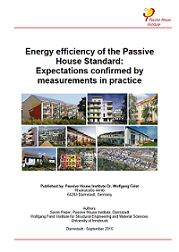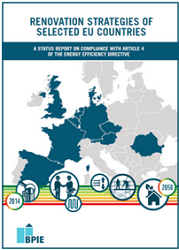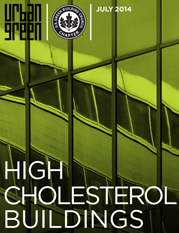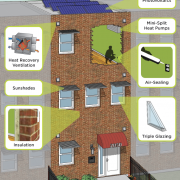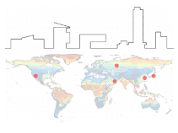Studies
Online literature sales
Literature can be selected by theme or chosen directly from the literature list. Please understand that many publications are available in German only. Publications available in English or other languages are marked accordingly. Additionally, many especially relevant excerpts have been translated and are available through Passipedia.
Overview of English language literature for purchase
Free technical literature and project reports
Most of the technical literature and project reports in the following categories are available for download as PDF files.
A full list of the Passive House Institute's Research group proceedings can be found here.
STUDY: Energy efficiency of the Passive House Standard: Expectations confirmed by measurements in practice
Authors: Søren Peper & Wolfgang Feist (Passive House Institute), 2015
The measured values from more than 1800 apartments in buildings built to the Passive House Standard and ca. 170 apartments which were refurbished with Passive House components prove that the Passive House concept leads to extremely high heating energy savings in a practically verifiable and reproducible manner; these savings amount to 90% compared with the old building standard and about 80% on average when compared with the legally stipulated requirements for new buildings. These savings have been proved through statistically significant empirical studies and have been confirmed in a large number of projects. The highest use-related individual consumption values of Passive House buildings are still far lower than the lowest consumption values in conventional new buildings.
REPORT: Renovation strategies of selected EU countries
Author: The Buildings Performance Institute Europe (BPIE), 2014
The BPIE´s report focuses on 10 Member States: Austria, Belgium (Brussels Capital Region), Czech Republic, Denmark, France, Germany, Netherlands, Romania, Spain and UK. The Member States were selected by BPIE for their building stock and climate diversity.
Download the report | Read the whole article
STUDY: Optimum glazing in the regions of Europe considering the embodied energy
Author: Benjamin Krick, Passive House Institute, July 2014
It is evident, that the U-value of glazing will decrease by increasing the number of panes and low-e-coatings, so the transmission losses through the glazing will decrease (just as the cooling load in cooling climates). At the same time, the g-value decreases too, so the solar gains are decreasing as well. In addition, the embodied energy increases with the overall thickness of the used glass, inert gas and the numbers of coatings. The task of this study was therefore to determine an overall energy balance (transmission losses, solar gains and embodied energy) over the life cycle of a glazing to carry out the best option in terms of the overall energy balance for the regions of Europe. Read more
REPORT: High Cholesterol Buildings
Author: Urban Green Council, July 2014
What's a high cholesterol building? One that’s on a fad diet today but will have severe environmental problems in the future.
It turns out there’s a loophole in our energy code that allows designers to trade off energy-draining envelopes for better mechanical equipment. Decades from now, that equipment will be replaced several times over, while the envelope remains, inefficient as ever.
The report shows that you would have to go back over 1,000 years to find buildings that used as little insulation as today’s all-glass structures. But with better glass, designed views, improved construction training, and greener codes, we can have buildings that are as healthy as they are beautiful.
Read the report | Read the Wall Street Journal story | VIEW the full report online
STUDY: Deep renovation of buildings: An effective way to decrease Europe’s energy import dependency
Author: Ecofys, May 2014
It is widely acknowledged that renovating dwellings and commercial buildings in the EU will have a large impact on the use of energy. This study links shows the strong link between building renovation and the EU’s dependency of imported energy carriers, showing that shallow renovations combined with large shares of renewables cannot compete with the benefits deep renovation can provide. Download study
REPORT: 90 by 50: NYC Can Reduce Its Carbon Footprint 90% By 2050
Author: Urban Green Council, February 2013
Urban Green Council’s latest research report, 90 by 50, demonstrates that the emission reductions required are in fact possible using technologies that are known and in almost all cases currently available, and that the cost is manageable from a citywide perspective. The study comes the same conclusions as EuroPHitters have by basically outlining EnerPHit retrofitting measures for New York City.
Read the article | DOWNLOAD the full report | VIEW the full report online | 90 by 50 presentation
Passive House for different climate zones
Author: Jürgen Schnieders, Passive House Institute
Passive House Institute and Rongen Architects have performed a research project dealing with Passive House and its specific requirements in different climate zones. Based on 5 locations representing different climate zones ranging from extremely cold to very hot and humid climates (Yekaterinburg, Tokyo, Shanghai, Las Vegas and Dubai), the project was aimed at identifying adequate technical solutions and analysing the impact of different parameters on a building’s energy balance for each climate. Based on these findings, building examples fulfilling high architectural standards were developed for each of these locations. The project was rounded off by a global definition of the Passive House Standard, applicable for all climates.
The key findings of this project: No matter the location, Passive Houses can be built in a cost- effective way with regard to their life-cycle costs, although the concept of consistent heating and cooling load minimisation seems to reach its limits in extremely cold or hot regions.
The 500 page project report has just been released in English and German and is available for purchase through the PHI website.
REPORT: IEA Solar Heating and Cooling Task 37-From Demonstration Projects to Volume Market
RELEASED BY: The International Energy Agency Task on Advancing Housing Renovation
How do we get from demonstration projects to a volume market for very low energy demand in advanced housing renovation? Repeatedly noting the importance of the Passive House Standard and Passive House renovations in this field, this International Energy Agency report aims to provide a better understanding of what drives advanced housing renovation, especially, the uptake of the Passive House Standard. It provides a reference document designed to inform and recommend directions for policymakers and central decision makers. Read report [PDF - 5 MB]
STUDY: Passive Houses in the Mediterranean
Author: Jürgen Schnieders, Passive House Institute, 2009
How does a Passive House in Palermo or Sevilla look? Researcher Jürgen Schnieders from the Passive House Institute, Darmstadt takes a critical look at answers to this question in his dissertation, Passive Houses in Mediterranean Climates, in which he shows that Passive Houses are also possible in the Mediterranean. In so doing, he calls attention to the fact that the utility of the Passive House concept is not just limited to the cooler climates of middle Europe, but extends to warms climes: proof that the Passive House concept can contribute to emissions reductions the world over. Read more
The Passive House Standard for India
PHI's Naman Sukhija wrote an article on the Passive House Standard for India.
Read more





